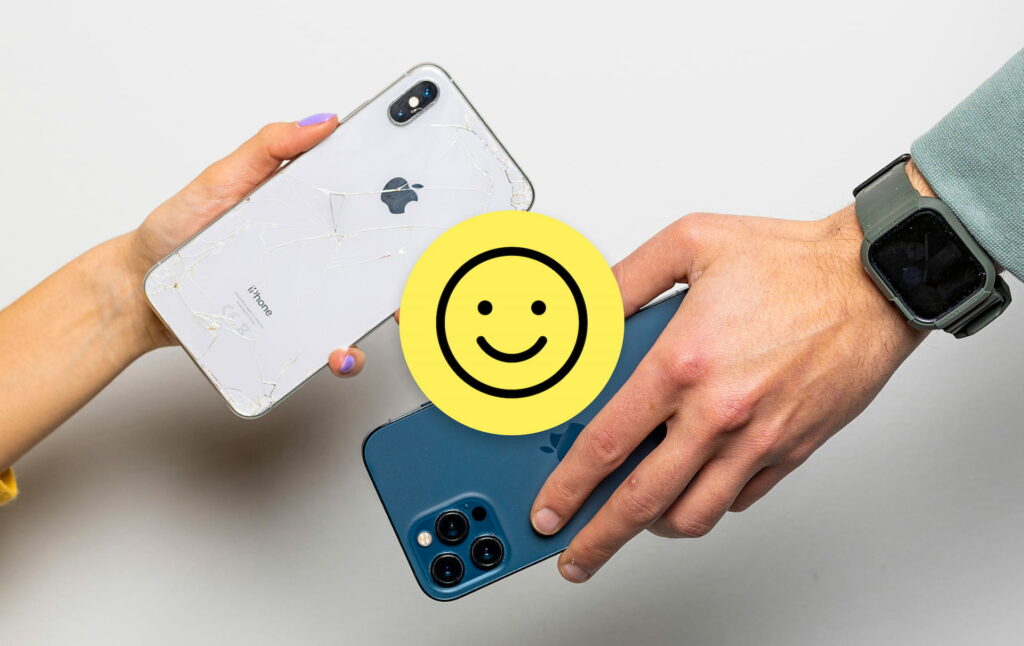Trade-in is a great way for retaining customers but not every trade-in program is created equal. You need to incorporate a few key features to set yourself apart from the pack, aiming to not only satisfy your users’ needs but also convince them that your solution is the best. Here’s how to ensure that:
1. Make it easy and convenient
A trade-in program should be as simple as a 1-2-3 process. If you add unnecessary steps into the user’s journey, people will get frustrated and give up on it. Can you make it as simple as the user bringing their device and getting an offer in a few minutes?
Here’s an example from our team: The way we did that in Pandas was to create a network of entry points for our customers, streamlining the entire process down to every detail. Firstly, rather than offering trade-in options only in-store, we also expanded our services to include online buybacks and various drop-off options. Secondly, we structured our warehouse to allow fast device grading, without issues or delays. Additionally, right at the beginning of the process, we collect all necessary information about each device (such as maker, model, color, storage, IMEI numbers etc) automatically or with very minimal input from the user.
2. Go quick, quick, quick!
Time is your biggest enemy. Don’t make users wait weeks before their smartphone trade-in is completed. Most programs out there have a 3-week lag time between when a person trades in their device and when they receive payment for it. The reason? There is usually a lack of coordination between the warehouse and each store evaluating the devices, leading to constant back and forths, therefore extending the whole process. One way to approach this is first and foremost with how you build your product and your internal teams. Can technology replace time-consuming, manual parts in the evaluation? Go ahead!
Here’s another example of what we did. Pandas followed this approach: our customers can visit a dedicated web app we have built that takes them through a series of quick tests and gamified checks to assess all of their smartphone’s components. In less than five minutes, they are given a specific price quote and all they need to do is drop off their device at one of our autonomous kiosks or in-store. Already, this route has allowed us to evaluate remotely any device, get very specific information about its condition and provide our customers with an offer before they even have to leave their houses.
3. Be as accurate as possible
Fast and easy are good, but being able to correctly assess and grade a device is the lifeblood of this business. Use technology that automates the process and it’s laborless (as much as possible). Technological efficiencies reduce your cost per device graded making a visible difference in your bottom line.
Bonus tip from our experience: make the whole grading process completely transparent by showcasing users what you are checking and what is happening with their device in every step of the way. This increases confidence, which makes it less likely that they will dispute any of your decisions about its condition or acceptability for trade-in.
4. Have you got the right pricing?
This can get very complex very quickly. What is your ideal strategy (for the 1,000+ different trade-in models) that is both competitive as well as allowing you to offer fair prices to your customers? A safe way to approach this is by using technology that offers an algorithmic, data-driven approach. In other words, the price you give to your customer should combine historical data about the device’s price quotes as well as regularly cross-check it weekly with the demand it has on the market. If you take into account all this information, in the long term, you will manage to reduce your cost per device graded.
Furthermore, the most important attribute you need to consider when shaping your pricing strategy is your customer’s lifetime value. The fairer your pricing strategy is, the higher your retention rate. Users are more likely to choose your program again for trading in their next device or recommend it to their friends. Your business outlook will then be more viable with customers who are loyal to your brand.
5. Security above all.
With all the personal data stored in a device, people justifiably demand security when trading in a smartphone. As customer surveys indicate, in regards to how trustworthy trade-in is, security is high on their list of concerns, given that their devices store not only photos but multiple passwords, accounts, and emails. So be sure to avoid using cables to evaluate a smartphone. Instead, prefer technology that is wireless to ensure that you don’t access any user-sensitive data.
Additionally, while it’s important to ensure your employees are trained in the proper way to assess a device, it’s also crucial that you keep them up-to-date with local privacy laws. Your business needs to be compliant with all security precautions. It’s not just the lawful thing to do but the right one too.
And don’t forget about the tools and/or services you use too. Do they have robust security protocols that do not intercept pre-existing sensitive information? Make a note to regularly check on that.
As long as the device’s content remains safe, you are safe and the user is happy. It’s a win-win for all.
6. Can you make it trackable?
Logistics can sometimes be tricky, especially if you deal with a large network of trade-in locations. Being able to track all the devices you receive (ideally at an IMEI level) will have a two-fold benefit for you: firstly, it allows you to know where your stock is at all times while minimizing loss and theft. When the time comes for your program to scale, you will be receiving thousands of smartphones on a regular basis and your warehouse needs to be prepared and structured in a way that can handle larger volumes, without skipping a beat. Trust us, we’ve been there! Secondly, the volume and the types of devices you receive equal very helpful statistics about what is the state of the market. What kind of models do consumers trade in more? What parts of them are usually faulty? How often do they upgrade? And more! Already having a system to track all this information and utilizing it will give you more confidence to make strategic decisions in your business down the line.
In the end…
If your trade-in program is to be successful, it needs to be intuitive and seamless. If you can make it so that users trust your product by default, without having to think too much when they wish to upgrade or trade in their smartphones, they’ll appreciate the experience. By incorporating a few key features into your program, like automatic processing and immediate pricing on new devices, you’ll set yourself apart from the competition.
If you are interested to know more about how Pandas can help you set up your trade-in program from start to finish, get in touch with our team. We’d love to show you!




